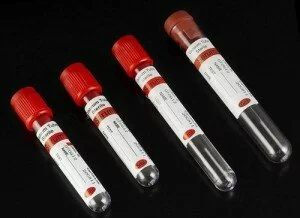
Serum Blood Collection Tubes
The following is an excerpt from a DWI Journal Article:
Most statutes define blood alcohol content in terms of grams of alcohol per 100 milliliters (g/100 mL) of blood. Serum and plasma samples are typically expressed in milligrams of alcohol per deciliter (mg/dL). Milligrams are converted to grams by dividing by 1000. The law of most states further provides that serum, plasma, or urine alcohol concentrations shall be expressed as an equivalent whole blood alcohol concentration and in these states tests performed on serum or plasma rather than whole blood may not suffice.1 Although the law in some states specifically indicates that a particular and specific conversion factor be applied to serum tests, most don’t, and it is abundantly clear that although legislators may be able to reach agreement on a single conversion factor the medical community certainly cannot. There is also no scientific agreement relative to how this conversion factor is to be derived. Moreover, from a scientific perspective it is clearly inappropriate for most individuals to use an average ratio to convert a serum alcohol measurement to a whole blood alcohol measurement because some individuals will have a ratio that differ from these averages.2
The typical legal or “forensic” blood alcohol test involves testing the headspace gas produced from a preparation made from the subject’s whole blood. Whole blood is defined as blood from which none of the elements have been removed.3 More specifically, whole blood is a complex tissue comprised of red and white blood cells, platelets and other clotting and cellular materials, water, and dissolved salts, amino acids and fats.4 All forensic laboratories test whole blood using gas chromatography.
Serum testing is significantly different than whole blood testing because with serum testing, the solid portion of the blood is first removed by spinning the blood in a centrifuge.
The unique qualities of ethanol results in the fact that after spinning the ethanol “follows” and stays with the water. Serum blood, therefore, contains more water per unit volume (milliliter) than does whole blood, because after centrifuging, more ethanol will be present in a milliliter of serum blood than in a comparative milliliter of whole blood. The serum blood sample is usually then tested by the “enzymatic” method. Because of the many problems associated with serum testing, as described here and below, a hospital serum ethanol test is most often used as a clinical screening tool to determine if a patient has ethanol exposure at levels that might affect the course of treatment. While it is true that such medical determination requires a reasonably accurate result, the emphasis in the hospital setting is to obtain an approximate or qualitative result rather than a precise quantitative result.
Primarily because of the differences in the comparative volumes of water mentioned above, the alcohol content of whole blood is not of the same alcohol content of the serum portion of the blood.5 Serum values are always higher than whole blood values. Consequently, in order to give the serum test result meaning, a reliable conversion factor must be employed. On average, serum values are about 16% higher than whole blood. But it is not uncommon to see results that may be 18% to 20% higher, or more, in some cases.6 In fact, an authoritative medical journal found that the upper conversion range can be as high as 25% for a small percentage of the population.7 While there is scientific uncertainty over the exact proper conversion factor, the reported studies all indicate that serum values are significantly higher than standard whole blood values.8
1. See, e.g., Com. v. Wanner, 605 A.2d 805, 808 (Pa.Super. 1992)
2. Petrie M. Rainey, Relation Between Serum and Whole-Blood Ethanol Concentrations, 39 Clinical Chemistry 2288 (1993).
3. Dorland’s Illustrated Medical Dictionary (30th ed.2003).
4. Stefan Rose, M.D. & Kenneth G. Furton, Ph.D., Fundamentals of Forensic Chemical Analysis 25 (2005).
5. Newcomb v. State, 758 N.E.2d 69, 71 (Ind.App. 2001)
6. Edward F. Fitzgerald, Intoxication Test Evidence, §19:4 (2nd ed. 2003).
7. E.A. Hak, B.J. Gerlitz, P.M. Dermont & W.D. Bowthorpe, Determination of Serum Alcohol: Blood Alcohol Ratios, 28 Can. Soc. Forensic Science Journal, No. 2 (1995).
8. N.K. Shajani, W. Godolphin, & B.A. Image., Blood Alcohol Analysis: Comparison of Whole Blood Analysis by Gas Chromatography with Serum
Analysis by Enzymatic Method, 22 Can. Soc. Forensic Science Journal, No. 4 (1989).










{ 1 trackback }